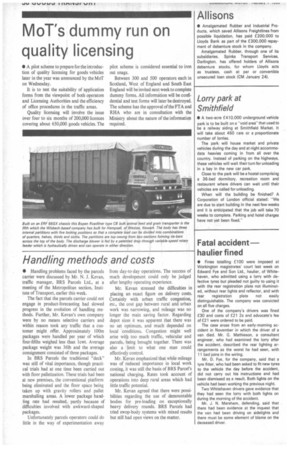Handling methods and costs
Page 38

If you've noticed an error in this article please click here to report it so we can fix it.
• Handling problems faced by the parcels carrier were discussed by Mr. N. J. Kevan, traffic manager, BRS Parcels Ltd., at a meeting of the Metropolitan section, Institute of Transport, earlier this week.
The fact that the parcels carrier could not engage in product-forecasting had slowed progress in the evolution of handling methods. Further, Mr. Kevan's own company were by no means selective carriers and within reason took any traffic that a customer might offer. Approximately 100m packages were handled per year of which four-fifths weighed less than lcwt. Average package weight was 361b and the average consignment consisted of three packages.
In BRS Parcels the traditional "deck" was still of vital importance, though practical trials had at one time been carried out with floor palletization. These trials had been at new premises, the conventional platform being eliminated and the floor space being taken up with gravity rollers and pallet marshalling areas. A lower package handling rate had resulted, partly because of difficulties involved with awkward-shaped packages.
Unfortunately parcels operators could do little in the way of experimentation away from day-to-day operations. The success of much development could only be judged after lengthy operating experience.
Mr. Kevan stressed the difficulties in placing an exact figure on delivery costs. Certainly with urban traffic congestion, etc., the cost gap between rural and urban work was narrowing, and mileage was no longer the main saving factor. Regarding depot sizes it was apparent that there was no set optimum, and much depended on local 'conditions. Congestion might well arise with too much traffic, vehicular and parcels, being brought together. There was also a limit to what one man could effectively control.
Mr. Kevan emphasized that while mileage was of reduced importance in local work costing, it was still the basis of BRS Parcel's national charging. Rates took account of operations into deep rural areas which had little traffic potential.
Mr. Kevan agreed that there were possibilities regarding the use of demountable bodies for pre-loading on exceptionally heavy delivery rounds. BRS Parcels had tried swop-body systems with mixed results but still had open views on the matter.












































































































































































